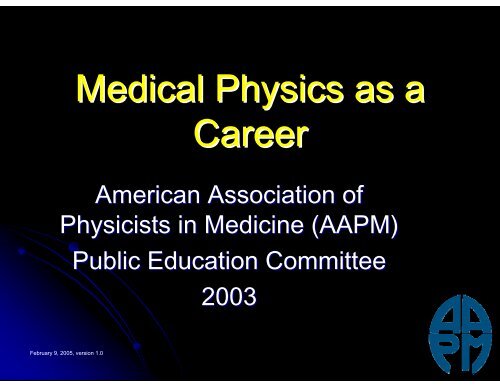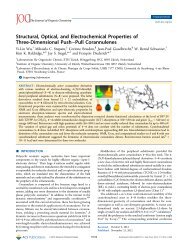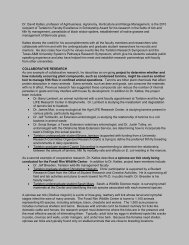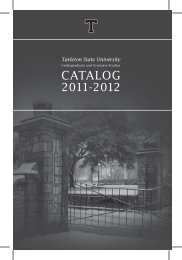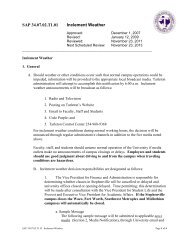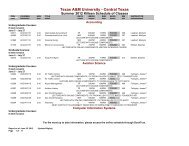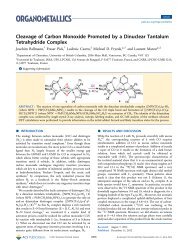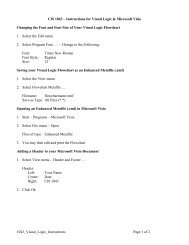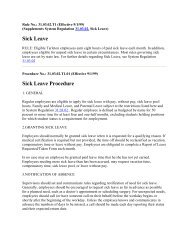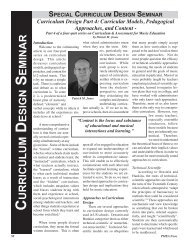Medical Physics as a Career - Tarleton State University
Medical Physics as a Career - Tarleton State University
Medical Physics as a Career - Tarleton State University
Create successful ePaper yourself
Turn your PDF publications into a flip-book with our unique Google optimized e-Paper software.
<strong>Medical</strong> <strong>Physics</strong> <strong>as</strong> a<br />
<strong>Career</strong><br />
American Association of<br />
Physicists in Medicine (AAPM)<br />
Public Education Committee<br />
2003<br />
February 9, 2005, version 1.0
What is a <strong>Medical</strong> Physicist?<br />
A medical physicist is a professional<br />
who specializes in the application of<br />
the concepts and methods of physics<br />
to the diagnosis and treatment of<br />
human dise<strong>as</strong>e.
The <strong>Medical</strong> Physicist<br />
Bridges <strong>Physics</strong> and Medicine<br />
<strong>Medical</strong> Physicist<br />
<strong>Physics</strong><br />
Medicine
The <strong>Medical</strong> Physicist is Part of<br />
the <strong>Medical</strong> Team<br />
Therapy<br />
Imaging<br />
• Physician (Radiation<br />
Oncologist, Surgeon, …)<br />
• <strong>Medical</strong> Physicist<br />
• <strong>Medical</strong> Dosimetrist<br />
• <strong>Physics</strong> Assistant<br />
• Radiation Therapist<br />
• Physician (Radiologist,<br />
Cardiologist, …)<br />
• <strong>Medical</strong> Physicist<br />
• <strong>Physics</strong> Assistant<br />
• Radiological Technologist
<strong>Medical</strong> Physicist Rewards<br />
• Challenge of applying the principles of<br />
physics to medicine<br />
• Satisfaction of developing new<br />
technology for medical use<br />
• Contributing to the well-being of patients<br />
• Receiving competitive compensation
What do we mean- a qualified<br />
medical physicist?<br />
• An individual who is competent to practice<br />
independently in one or more of the subfields in<br />
medical physics.<br />
• Certification and continuing education (to<br />
demonstrate competence)<br />
• Trained to be familiar with the principles of physics<br />
used in the equipment and instruments<br />
• Familiar with government regulations and laws<br />
• Familiar with performance specifications of equipment<br />
• Familiar with physical limitations of instruments,<br />
calibration procedures, and computer algorithms
<strong>Medical</strong> <strong>Physics</strong> Disciplines<br />
(Subfields)<br />
• Therapeutic Radiological <strong>Physics</strong><br />
• Diagnostic Imaging <strong>Physics</strong><br />
• <strong>Medical</strong> Nuclear <strong>Physics</strong><br />
• <strong>Medical</strong> Health <strong>Physics</strong><br />
AAPM By-Law
Therapeutic Radiological <strong>Physics</strong><br />
• The therapeutic applications of x-ray, x<br />
gamma<br />
ray, neutron, electron, and charged-particle<br />
beams, and radiation from sealed radionuclide<br />
sources.<br />
• The equipment <strong>as</strong>sociated with their production,<br />
use, me<strong>as</strong>urement, and evaluation.<br />
• The quality of images resulting from their<br />
production and use.<br />
• <strong>Medical</strong> health physics <strong>as</strong>sociated with this<br />
subfield.<br />
AAPM By-Law
Cell Killing By Ionizing Radiation
Diagnostic Radiological <strong>Physics</strong><br />
• The diagnostic applications of x-rays, x<br />
gamma<br />
rays from sealed sources, ultr<strong>as</strong>onic radiation,<br />
and radio frequency radiation and magnetic<br />
fields<br />
• The equipment <strong>as</strong>sociation with their production,<br />
use, me<strong>as</strong>urement and evaluation<br />
• The quality of images resulting from their<br />
production and use<br />
• <strong>Medical</strong> health physics <strong>as</strong>sociated with this<br />
subfield<br />
AAPM By-Law
Discovery of X-raysX<br />
On 8 Nov 1895, Wilhelm Conrad Röntgen<br />
(accidentally) discovered an image c<strong>as</strong>t<br />
from his cathode ray generator.
<strong>Medical</strong> Nuclear <strong>Physics</strong><br />
• The therapeutic and diagnostic applications of<br />
radionuclides in unsealed sources<br />
• The equipment <strong>as</strong>sociation with their production,<br />
use, me<strong>as</strong>urement, and evaluation<br />
• The quality of images resulting from their<br />
production and use<br />
• <strong>Medical</strong> health physics <strong>as</strong>sociated with this<br />
subfield<br />
AAPM By-Law
Gamma Camera Scan<br />
Liver met<strong>as</strong>t<strong>as</strong>is from<br />
prostate carcinoma<br />
IV administration of Tc99m<br />
Accumulates in are<strong>as</strong> of<br />
incre<strong>as</strong>ed blood flow due to<br />
active bone metabolism,<br />
oedema of inflammation or<br />
the angiogenesis <strong>as</strong>sociated<br />
with tumours
<strong>Medical</strong> Health <strong>Physics</strong><br />
• The safe use of x-ray, x<br />
gamma ray,<br />
neutron, electron, and other charged<br />
particle beams or radionuclides in<br />
medicine (for diagnostic or therapeutic<br />
purposes).<br />
• The instrumentation required to perform<br />
appropriate radiation surveys.<br />
• The medical physicist often serves <strong>as</strong><br />
radiation safety officer<br />
AAPM By-Law
Emergency Management of<br />
Radiation C<strong>as</strong>ualties<br />
CAUTION<br />
February 9, 2005, version 1.0
What is the <strong>Medical</strong> Physicist’s<br />
Primary Discipline?<br />
3% 4% 1%1%<br />
15%<br />
Radiation Therapy<br />
Imaging <strong>Physics</strong><br />
Nuclear Medicine<br />
Health <strong>Physics</strong><br />
Engineering<br />
Administration<br />
76%<br />
Source: 2002 AAPM Survey
What is the <strong>Medical</strong> Physicist’s<br />
Primary Responsibility?<br />
8%<br />
5% 3% 4% 2%<br />
Clinical<br />
Academic<br />
Research<br />
Administrative<br />
Regulatory<br />
Product<br />
Development<br />
78%<br />
Source: 2002 AAPM Survey
General Are<strong>as</strong> of Responsibility<br />
of the <strong>Medical</strong> Physicist<br />
• Clinical<br />
• Research<br />
• Education<br />
• Regulatory Compliance
Clinical Responsibilities of the<br />
<strong>Medical</strong> Physicist<br />
• Daily clinical support<br />
• Equipment acquisitions<br />
• Site planning<br />
• Quality <strong>as</strong>surance<br />
• Dose calculations<br />
• Liaison between other medical<br />
professionals, manufacturers, and<br />
regulatory agencies
Research and Development<br />
Opportunities for the <strong>Medical</strong> Physicist<br />
• Develop new therapeutic or diagnostic<br />
procedures<br />
• Implement and/or integrate new<br />
equipment into clinical use<br />
• Investigate or evaluate therapeutic or<br />
diagnostic outcomes/performance<br />
• B<strong>as</strong>ic scientific research
Educational Functions of the<br />
<strong>Medical</strong> Physicist<br />
• Graduate programs in <strong>Medical</strong> <strong>Physics</strong><br />
• Residency programs<br />
• <strong>Medical</strong> <strong>Physics</strong><br />
• Diagnostic Radiology<br />
• Radiation Oncology<br />
• Nuclear Medicine<br />
• Others (Cardiology, Gynecology, …)<br />
• Allied Health Professionals<br />
• Other training opportunities<br />
• AAPM annual meeting and summer school<br />
• ACMP seminars<br />
• Other professional society meetings
Therapeutic Radiological<br />
<strong>Physics</strong><br />
An Introduction<br />
February 9, 2005, version 1.0
Modern Radiation Therapy Using<br />
High Energy X-rays X<br />
and Electrons
Isocentric Patient<br />
Radiation Therapy
Therapeutic Gain<br />
A compromise between tumor control and normal tissue complications<br />
100<br />
Complication (%)<br />
50<br />
Normal<br />
Tissue Damage<br />
Tumor<br />
Cell Killing<br />
Tumor Control (%)<br />
Dose (Gy)
External Beam Radiation Therapy<br />
25 Gy<br />
45 Gy<br />
78 Gy<br />
65 Gy<br />
70 Gy<br />
76 Gy<br />
3D Conformal Technique for Treating Prostate Cancer
9-Field Head & Neck IMRT C<strong>as</strong>e<br />
Int J Radiat Oncol Biol Phys 2001;51:880-914
Target Localization and Immobilization Using<br />
Ultr<strong>as</strong>ound in Prostate Radiation Therapy
Example of Functions In Therapy<br />
<strong>Physics</strong><br />
•Clinical <strong>Medical</strong> <strong>Physics</strong><br />
Dosimetry, radiation safety,<br />
quality <strong>as</strong>surance, etc.<br />
•Research and Development<br />
Develop new therapeutic<br />
equipment or procedures, etc.<br />
•Education<br />
Training of medical physicists,<br />
physicians, technologists,<br />
radiation therapists, and<br />
medical dosimetrists.<br />
Contributed By: Dong (MD Anderson)
Therapy Responsibilities<br />
• Equipment and facility specification and<br />
acquisition<br />
B<br />
x<br />
=<br />
Pd<br />
2<br />
pri<br />
WUT<br />
Shielding<br />
calculations<br />
Contributed By: Dong (MD Anderson)
Therapy Responsibilities<br />
• Equipment<br />
commissioning<br />
Contributed By: Dong (MD Anderson)
Therapy Responsibilities<br />
• Calibration of radiation sources<br />
Contributed By: Dong (MD Anderson)
Therapy Responsibilities<br />
• Planning of patient procedures<br />
Contributed By: Dong (MD Anderson)
Therapy Responsibilities<br />
• Calculation of patient dose<br />
60Gy in 30 Fractions<br />
Contributed By: Dong (MD Anderson)
Therapy Responsibilities<br />
• Management of special<br />
procedure:<br />
stereotactic radiosurgery
Therapy Responsibilities<br />
• Calibration and quality <strong>as</strong>surance<br />
Contributed By: Dong (MD Anderson)
Therapy Responsibilities<br />
• Development of new devices and<br />
techniques<br />
Contributed By: Dong (MD Anderson)
Therapy Responsibilities<br />
• Radiation safety
Therapy Responsibilities<br />
• Regulatory compliance<br />
(examples)<br />
U.S. Nuclear Regulatory Commission
Diagnostic Radiological<br />
<strong>Physics</strong><br />
An Introduction<br />
February 9, 2005, version 1.0
Components in Diagnostic Imaging<br />
• Clinical images<br />
• Imaging <strong>Physics</strong> and Principles<br />
• Quality Control (QC) tests<br />
• Radiation dose and effects in patients<br />
• Shielding or sitting considerations
Diagnostic Use of X-raysX
Angiography – Subtraction Imaging
Computed Radiography<br />
AC-3<br />
ADC / EDR<br />
PACS<br />
Soft-Copy Read<br />
Hard<br />
Copy<br />
QCW<br />
Network
Computed Tomography Principle<br />
X-rays<br />
intensity<br />
angle
Computed Tomography (CT)<br />
Back Projection<br />
Use 1D projection<br />
<strong>as</strong> a template<br />
Back projection<br />
of pixel<br />
brightness<br />
PROJECTION<br />
RECONSTRUCTION<br />
http://www.colorado.edu/physics/2000/index.pl
Example of a CT Image of Abdomen<br />
Axial image looking up<br />
from the feet.<br />
Liver met<strong>as</strong>t<strong>as</strong>is from<br />
colon carcinoma
CT - Covers Off !!!
Quality Assurance of CT Scanner
Magnetic Resonance Imaging (MRI)<br />
Zero External Magnetic Field<br />
Point in random directions.
Magnetic Resonance Imaging (MRI)<br />
In Strong External Magnetic Field<br />
Strong<br />
Magnetic<br />
Field<br />
Some line up. Some line down. Just the majority line up.<br />
Out of 1 million ~ 500,002 UP – 499,998 DOWN.
Magnetic Resonance Imaging (MRI)<br />
Flipping Spins<br />
Radiofrequency<br />
Pulse<br />
Main<br />
magnetic<br />
field (~ 1.5 T)<br />
Bulk<br />
Magnetisation<br />
‘M’<br />
Wobbling<br />
‘gyroscope’<br />
motion.<br />
Precession<br />
N<br />
EMFs<br />
induced<br />
S<br />
To computer
Magnetic Resonance Imaging (MRI)<br />
Nuclear Relaxation and Image Contr<strong>as</strong>t<br />
Z<br />
Spin-Lattice (or T 1 ) Relaxation.<br />
Direction of<br />
magnetic field B<br />
M z<br />
M<br />
Tipping back up of the<br />
bulk magnetisation (M).<br />
Re-aligns with B.<br />
T 1 ~ 1 second for tissues.<br />
X<br />
Y<br />
Proton density variations < 10%<br />
T 1 variations can be ~ 700%
Magnetic Resonance Imaging (MRI)<br />
Axial Brain Images<br />
T 1 -weighted T 2 -weighted Proton density<br />
weighted
MR Spectroscopy<br />
NAA<br />
Cr<br />
PCr<br />
GABA<br />
Glu, Gln<br />
Cr<br />
Glu<br />
Gln<br />
Ins<br />
Cho<br />
Asp<br />
NAA<br />
Lactate<br />
Lipids
MR Spectroscopy<br />
T1+C Cho/Cr Map Lipids
<strong>Medical</strong> Nuclear <strong>Physics</strong><br />
An Introduction<br />
February 9, 2005, version 1.0
<strong>Medical</strong> Nuclear <strong>Physics</strong><br />
• Functional and morphological imaging<br />
• Radionuclide therapies
Nuclear Medicine<br />
• Radioactive material attached to agent<br />
• Physical Half-life life of radioactive material<br />
• Biological Half-life life of radioactive material<br />
• A t = A 0 e -λt<br />
• Radiopharmaceutical administered to<br />
patient<br />
• Wait for distribution<br />
• Radioactivity yields images of function
Image Fusion: MRI and NMI<br />
MRI (anatomy)<br />
NMI (functional)
Positron Emission Tomography (PET)<br />
β + Decay<br />
Proton-rich radioisotopes e.g., 15 O, 11 C, 18 F<br />
Produced by proton bombardment in a particle<br />
accelerator called a CYCLOTRON<br />
Decay by: p → n e + ν<br />
e + = positron. This is ANTI-MATTER.<br />
18<br />
F – ½ life ~ 110 minutes.<br />
11<br />
C – ½ life ~ 20 minutes.<br />
15<br />
O – ½ life ~ 2 minutes!!<br />
⇒<br />
Get that cyclotron<br />
near the scanner!!
Positron Emission Tomography (PET)<br />
Rings of dense &<br />
segmented scintillation<br />
crystals (BGO) coupled to<br />
PMT’s surround patient.<br />
2 x 511 keV photons<br />
emitted back-to-back<br />
at annihilation.<br />
~ 1mm
Positron Emission Tomography (PET)<br />
Determining LINE OF RESPONSE (LOR) :<br />
POSITION detecting of crystal.<br />
CO-INCIDENCE circuits determine if<br />
detector directly opposite detected<br />
same event (within ~ 2ns).<br />
ENERGY of photon determined.<br />
Eliminates stray or scattered γ rays.<br />
Image ⇒ projection reconstruction<br />
along multiple LORs (like in CT).
Image of Human Brain - Stroke<br />
Glucose<br />
molecule<br />
labelled<br />
with<br />
Fluorine-18.<br />
“Dead” are<strong>as</strong> of brain<br />
No glucose metabolism<br />
Intravenous<br />
administration.
Example of Quality Assurance<br />
Linearity Corrections
Nuclear Medicine QC Image
<strong>Medical</strong> Health <strong>Physics</strong><br />
An Introduction<br />
February 9, 2005, version 1.0
Radiation Doses and Dose Limits<br />
Flight from Los Angeles to London<br />
Annual public dose limit<br />
Annual natural background<br />
Fetal dose limit<br />
Barium enema<br />
Annual radiation worker dose limit<br />
Heart catheterization<br />
5 mrem<br />
100 mrem<br />
300 mrem<br />
500 mrem<br />
870mrem<br />
5,000 mrem<br />
45,000 mrem<br />
Life saving actions guidance (NCRP-116) 50,000 mrem<br />
Mild acute radiation syndrome<br />
LD 50/60 for humans (bone marrow dose)<br />
Radiation therapy (localized & fractionated)<br />
200,000 mrem<br />
350,000 mrem<br />
6,000,000 mrem
Radioactive Material<br />
• Radioactive material consists of atoms<br />
with unstable nuclei<br />
• The atoms spontaneously change<br />
(decay) to more stable forms and emit<br />
radiation<br />
• A person who is contaminated h<strong>as</strong><br />
radioactive material on their skin or<br />
inside their body (e.g., inhalation,<br />
ingestion or wound contamination)
Types of Radiation Hazards<br />
• External Exposure -<br />
whole-body or partial-<br />
body (no radiation<br />
hazard to EMS staff)<br />
• Contaminated -<br />
• external radioactive<br />
material: on the skin<br />
• internal radioactive<br />
material: inhaled,<br />
swallowed, absorbed<br />
through skin or<br />
wounds<br />
External<br />
Exposure<br />
Internal<br />
Contamination<br />
External<br />
Contamination
Causes of Radiation<br />
Exposure/Contamination<br />
• Accidents<br />
• Nuclear reactor<br />
• <strong>Medical</strong> radiation therapy<br />
• Industrial irradiator<br />
• Lost/stolen medical or industrial<br />
radioactive sources<br />
• Transportation<br />
• Terrorist Event<br />
• Radiological dispersal device<br />
(dirty bomb)<br />
• Low yield nuclear weapon
Example: Facility Preparation<br />
• Activate hospital plan<br />
• Obtain radiation survey meters<br />
• Call for additional support: Staff from Nuclear<br />
Medicine, Radiation Oncology, Radiation Safety<br />
(Health <strong>Physics</strong>)<br />
• Plan for decontamination of uninjured persons<br />
• Establish triage area<br />
• Plan to control contamination<br />
• Instruct staff to use universal precautions and<br />
double glove<br />
• Establish multiple receptacles for contaminated<br />
w<strong>as</strong>te<br />
• Protect floor with covering if time allows
Example: Patient Management - Triage<br />
Triage b<strong>as</strong>ed on:<br />
• Injuries<br />
• Signs and symptoms -<br />
nausea, vomiting, fatigue,<br />
diarrhea<br />
• History - Where were you<br />
when the bomb exploded?<br />
• Contamination survey
Example: Facility Recovery<br />
• Remove w<strong>as</strong>te from the Emergency<br />
Department and triage area<br />
• Survey facility for contamination<br />
• Decontaminate <strong>as</strong> necessary<br />
• Normal cleaning routines (mop, strip waxed<br />
floors) typically very effective<br />
• Periodically re<strong>as</strong>sess contamination levels<br />
• Replace furniture, floor tiles, etc. that cannot<br />
be adequately decontaminated<br />
• Decontamination Goal: Less than twice<br />
normal background…higher levels may be<br />
acceptable
Educational Opportunities
Professional Training<br />
• Academic Training<br />
• MS or PhD in medical physics, or<br />
• MS or PhD in physics or related discipline with<br />
post-graduate academic training in medical<br />
physics.<br />
• Clinical Training<br />
• Residency in clinical medical physics, and/or<br />
• Supervised on-the<br />
the-job training in clinical medical<br />
physics.
Pathways into <strong>Medical</strong> <strong>Physics</strong><br />
B.S. in <strong>Physics</strong><br />
or related field<br />
M.S. or Ph.D. in <strong>Physics</strong><br />
or related field<br />
M.S. or Ph.D. in <strong>Medical</strong> <strong>Physics</strong><br />
<strong>Medical</strong> <strong>Physics</strong><br />
Postdoctoral Training<br />
<strong>Medical</strong> <strong>Physics</strong><br />
Residency Program<br />
On the Job Clinical Training<br />
in <strong>Medical</strong> <strong>Physics</strong><br />
On the Job Clinical Training<br />
in <strong>Medical</strong> <strong>Physics</strong><br />
Practicing <strong>Medical</strong> Physicists<br />
Contributed By: Dong (MD Anderson)
Example Graduate Program Requirements<br />
(Univ. of Tex<strong>as</strong> Graduate School of Biomedical Sciences, Houston)<br />
• M.S. Program<br />
• 34 semester hours of didactic curricula<br />
• Diagnostic imaging physics clinical rotation<br />
• Radiation therapy physics clinical rotation<br />
• Thesis<br />
• Ph.D. Program<br />
• M.S. Program requirements<br />
• 3 Research tutorials<br />
• Oral candidacy exam<br />
• Dissertation<br />
Contributed By: Hogstrom (MD Anderson)
Required Courses<br />
• Mathematics for <strong>Medical</strong> <strong>Physics</strong><br />
• Electronics for <strong>Medical</strong> Physicists<br />
• Radiation Detection, Instrumentation, and Data<br />
Analysis<br />
• Intro Med Phys I: B<strong>as</strong>ic Interactions<br />
• Intro Med Phys II: <strong>Medical</strong> Imaging<br />
• Intro Med Phys III: Therapy<br />
• Intro Med Phys IV: Nuclear Medicine<br />
• <strong>Medical</strong> <strong>Physics</strong> Seminars (3)<br />
Contributed By: Hogstrom (MD Anderson)<br />
Example <strong>Medical</strong> <strong>Physics</strong> Curricula<br />
(Univ. of Tex<strong>as</strong> Graduate School of Biomedical Sciences, Houston)
Example <strong>Medical</strong> <strong>Physics</strong> Curricula<br />
(Univ. of Tex<strong>as</strong> Graduate School of Biomedical Sciences, Houston)<br />
• Radiation Biology<br />
• Radiation Protection<br />
• Anatomy and Oncology for <strong>Medical</strong> Physicists<br />
• Introductory Biochemistry (Ph.D. only)<br />
• Ethical Dimensions of the Biomedical Sciences<br />
Electives<br />
• <strong>Physics</strong> and Applications of Electron Beam Transport<br />
• Commissioning and QA of RT Planning Systems<br />
• Digital Processing of Biomedical Images<br />
• Principles of Magnetic Resonance Imaging<br />
• <strong>Physics</strong> of Positron Emission Tomography<br />
Contributed By: Hogstrom (MD Anderson)
CAMPEP-Accredited<br />
Accredited<br />
Graduate Education Programs<br />
As of July 2003, there were 9 accredited programs:<br />
• McGill <strong>University</strong> - Montreal<br />
• <strong>University</strong> of Florida<br />
• <strong>University</strong> of California - Los Angeles<br />
• <strong>University</strong> of Kentucky <strong>Medical</strong> Center<br />
• <strong>University</strong> of Oklahoma HSC<br />
• <strong>University</strong> of Tex<strong>as</strong> HSC - Houston<br />
• <strong>University</strong> of Tex<strong>as</strong> HSC - San Antonio<br />
• <strong>University</strong> of Wisconsin<br />
• Wayne <strong>State</strong> <strong>University</strong><br />
[For more info contact AAPM @ www.aapm.org or (301) 209-3350]
CAMPEP-Accredited<br />
Accredited<br />
Residency Education Programs<br />
As of July 2003, there were 5 accredited programs:<br />
• Radiation Therapy <strong>Physics</strong><br />
• Fairview <strong>University</strong> <strong>Medical</strong> Center (Minneapolis)<br />
• McGill <strong>University</strong> (Montreal)<br />
• <strong>University</strong> of Florida (Gainesville)<br />
• W<strong>as</strong>hington <strong>University</strong> School of Medicine (St.<br />
Louis)<br />
• Diagnostic Imaging <strong>Physics</strong><br />
• The <strong>University</strong> of Tex<strong>as</strong> M. D. Anderson Cancer<br />
Center (Houston)<br />
[For more info contact AAPM @ www.aapm.org or (301) 209-3350]
Professional Issues
American Association of<br />
Physicists in Medicine (AAPM)<br />
Mission <strong>State</strong>ment<br />
• To advance the practice of physics in<br />
medicine and biology by encouraging<br />
innovative research and development,<br />
disseminating scientific and technical<br />
information, fostering the education and<br />
professional development of medical<br />
physicists, and promoting the highest<br />
quality of medical services for patients.<br />
AAPM By-Law
2003<br />
2001<br />
1999<br />
1997<br />
1995<br />
6000<br />
5000<br />
4000<br />
3000<br />
2000<br />
1000<br />
0<br />
Total AAPM Membership<br />
1977<br />
1979<br />
1981<br />
1983<br />
1985<br />
1987<br />
1989<br />
1991<br />
1993<br />
Year<br />
1975<br />
Number of Members<br />
1969<br />
1971<br />
1973<br />
AAPM Membership Service
4,000<br />
Recent Full Members<br />
3,500<br />
Number of Members<br />
3,000<br />
2,500<br />
2,000<br />
1,500<br />
1,000<br />
500<br />
0<br />
AAPM Membership Service<br />
1990 1991 1992 1993 1994 1995 1996 1997 1998 1999 2000 2001 2002 2003<br />
Year
Professional Credentials of<br />
<strong>Medical</strong> Physicists<br />
• Education: : M.S. (51%) or Ph.D. (49%) in<br />
medical physics, physics, nuclear<br />
engineering, or related discipline<br />
• Certification: : By specialty<br />
• Licensure: : <strong>State</strong> licensure or registration<br />
• Hospital Credentials: : Procedure specific<br />
privileges
Professional Credentials<br />
• Board Certifications<br />
• American Board of Radiology<br />
• American Board of <strong>Medical</strong> <strong>Physics</strong><br />
• Licensure and Registration<br />
• Tex<strong>as</strong> (first in 1992), Florida, New York, and Hawaii<br />
• Licensure being pursued in California, and nationally<br />
• Many states require board certifications<br />
• Many states require registration<br />
• Professional Society Memberships
Professional Societies<br />
• <strong>Medical</strong> <strong>Physics</strong> Professional Societies<br />
• American Association of Physicists in Medicine<br />
• American College of <strong>Medical</strong> <strong>Physics</strong><br />
• Sister-Professional Societies<br />
• American Society of Therapeutic Radiology & Oncology<br />
• Radiological Society of North America<br />
• American College of Radiology<br />
• Society of Nuclear Medicine<br />
• International Society for Magnetic Resonance in Medicine<br />
• American Brachytherapy Society<br />
• Health <strong>Physics</strong> Society<br />
• …
Where are <strong>Medical</strong> Physicist’s<br />
Primary Employment?<br />
1%<br />
8%<br />
8%<br />
6%<br />
41%<br />
Private Hospital<br />
Government Hospital<br />
<strong>University</strong> Hospital<br />
Government<br />
Physicist's Service Group<br />
Physician's Service Group<br />
Industry<br />
33%<br />
3%<br />
Source: 2002 AAPM Survey
Average Income (MS Degree)<br />
Salary (Thousands)<br />
140<br />
120<br />
100<br />
80<br />
60<br />
40<br />
20<br />
0<br />
Total Annual Income<br />
0-2 3-4 5-9 10-14 15-19 20+<br />
Years of Experience<br />
Source: 2002 AAPM Survey<br />
No Certification<br />
Certification
Average Income (PhD Degree)<br />
Salary (Thousands)<br />
160<br />
140<br />
120<br />
100<br />
80<br />
60<br />
40<br />
20<br />
0<br />
Total Annual Income<br />
0-2 3-4 5-9 10-14 15-19 20+<br />
No Certification<br />
Certification<br />
Years of Experience<br />
Source: 2002 AAPM Survey
For More Information<br />
http://www.aapm.org<br />
American Association of Physicists in Medicine<br />
(AAPM) Public Education Committee 2003<br />
February 9, 2005, version 1.0


